- Submissions

Full Text
Trends in Textile Engineering & Fashion Technology
Clothing as a Compositional Resource in Artistic Plastic
Daniel Bilbao Peña*
Departament of Drawing´s, University of Seville, Spain
*Corresponding author: Daniel Bilbao Peña, Departament of Drawing´s, Fine Arts Faculty, University of Seville, Spain
Submission: September 24, 2018;Published: October 03, 2018

ISSN 2578-0271 Volume4 Issue2
Abstract
The plastic resources that have been used in different historical stages are adapted to the aesthetic needs of each time. The representation of fabrics is always linked to artistic art in both painting and sculpture. We will draw a fleeting glance between some historical stages to discover the keys that hide between their folds.
Development
Throughout the history of art, we can see how the representation of fabric and designs have evolved in line with the fashions of each era. Thus, there are identifiable plastic languages that can be established based on the representation of the schools that appear in each work. In the article “The textile contribution to the world of art” [1], he presented a brief historical overview of the evolution of textile treatment in the art world and contrasted the antagonistic artistic movements that showed a remarkable turn in the way of representing fabrics.
In this case, also relying on differences in the characteristics of some works from different artistic stages studied such as textiles have served as a resource for compositional reinforcement in most of the functions.
Take for case; work of the Gothic; the solemnity and gravity with which people can enhance the verticality of the character, contributing to the understanding an ascending sense that represents the spiritual interests of the moment.
Figure 1:
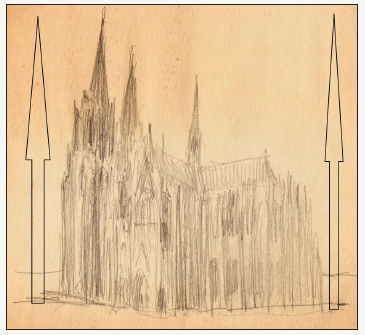
During the Gothic period, the Arts were conceived, to a large extent, as a means of education and diffusion of methods so that they hardly transmitted another form that most of the population did not know how to read or write. Architecture, painting, sculpture and even music, through the Gregorian chants, were responsible for spreading a religious message of spirituality and ancestry [2]. At this moment everything revolves around God, and man is conceived as one more element of his creation, so that his plastic representation manifests itself with vertical and ascending forms that raise the adoration of heaven. In this historical stage, the architecture of the great categories, the unusual heights (Figure 1), in comparison with previous periods, as in the Romanesque, the stage in which the churches were built with much smaller dimensions. Based on this, a large part of the sculptural and pictorial works is adapted to that architecture, which, in many cases, is the one that houses each piece in niches or ogival altarpieces (Figure 2).
Figure 2:
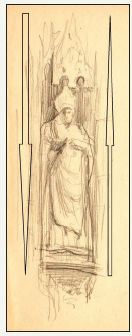
The compositions of the fabrics and the dresses of this time adopt that vertical and stylized movement that gives place to the works of elegance and distinction (Figure 3).
With the appearance of the Renaissance, the ideals become humanistic and the look turns to ancient Greece and Rome. Now is the man and the center of inspiration and around him will develop new interests such as the study of anatomical beauty. Therefore, human representation in painting, drawing and sculpture often appears nude or with little clothing. The fabrics are conceived in this stage as mere companions that allow to discover the body so that the spectator can admire its beauty (Figure 4).
Figure 3:
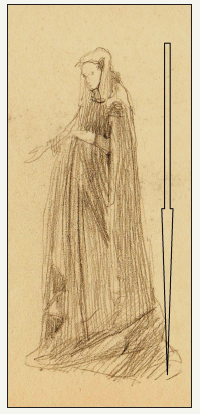
Figure 4:
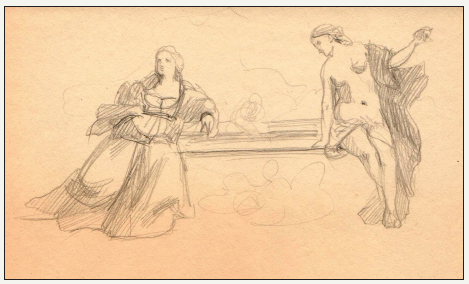
In the Baroque period he observes how the plastic conception undergoes a formal and conceptual change. In this stage the values are centered on an earthly and humanistic reality but adorned with a new conception of the compositional space. Now the compositions acquire a special dynamism and the movement and the position of the clothes are fundamental to achieve the desired effect (Figure 5).
Figure 5:
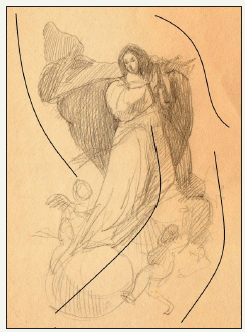
We can conclude that we determine the historical tendency of the facts with the cyclic-pendular characteristic, in such a way that with singular movements, they end up deriving tendencies in many cases, and with the subject that occupies us, the clothes and fabrics that we always accompany to the work artistic adopts the plastic design that each era requires, being determinant in most artistic compositions.
References
- https://crimsonpublishers.com/tteft/fulltext/TTEFT.000574.php
- Music AA VV (2015) Music history. In: Santillana (Ed.), Listening series.
© 2018 Daniel Bilbao Peña . This is an open access article distributed under the terms of the Creative Commons Attribution License , which permits unrestricted use, distribution, and build upon your work non-commercially.
 a Creative Commons Attribution 4.0 International License. Based on a work at www.crimsonpublishers.com.
Best viewed in
a Creative Commons Attribution 4.0 International License. Based on a work at www.crimsonpublishers.com.
Best viewed in 







.jpg)






























 Editorial Board Registrations
Editorial Board Registrations Submit your Article
Submit your Article Refer a Friend
Refer a Friend Advertise With Us
Advertise With Us
.jpg)






.jpg)














.bmp)
.jpg)
.png)
.jpg)










.jpg)






.png)

.png)



.png)






